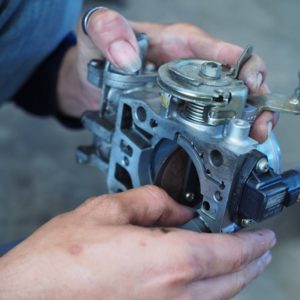On vehicles with electronic throttle control (ETC), there are two types of sensors that keep track of how wide the throttle body has opened. There are usually two throttle position sensors/switches found on the intake manifold’s throttle body, while there are pedal position sensors/switches on the accelerator pedal. Their readings tell the powertrain control module (PCM) the amount of engine power needed and how fast the engine needs to produce it.
If the PCM detects that the voltage output from the throttle position sensor is too low, it will log a P0222 code.
What Does the P0222 Code Mean?
The Diagnostic Trouble Code (DTC) P0222 indicates “Throttle/Pedal Position Sensor/Switch “B” Circuit Low.”
Each throttle position sensor regularly sends a voltage signal to the PCM. The signal’s voltage level varies according to the sensor’s current position, which in turn depends on the vehicle’s acceleration. Stepping on the accelerator pedal rotates the sensor, and its voltage signal tells the PCM just how wide the throttle has opened. The throttle plate will follow pedal movement even if the engine isn’t running, but the key must be on.

The PCM uses the readings from the throttle position sensor to adjust various engine-related processes, such as fuel delivery and ignition timing.
To ensure the throttle position sensor is working properly, the PCM regularly checks its voltage signal and compares it with a baseline. If the voltage level from the signal is much lower than it should be, the computer will set the code P0222.
For an in-depth understanding of electronic throttle control, read our technical discussion about throttle position sensors. You can find additional reading on codes similar to P0222 in our brief discussion about redundant sensors.
Note: The definition of code P0222 may differ according to the vehicle manufacturer. Check the appropriate repair manual or repair database for the exact code definition.
What are the Common Causes of the P0222 Code?
- Faulty throttle position sensor/switch
- Faulty pedal position sensor/switch
- Corroded or bad connections or wiring for the sensor/switches
- Throttle body clogged by carbon build-up or dirt
- An issue with the PCM, such as software in need of an update

What are the Common Symptoms of the P0222 Code?
- Check Engine Light will illuminate
- The engine goes through hard starts
- Engine hesitation while speeding up
- Stalling
- Vehicle stuck in “limp mode”
How to Diagnose the P0222 Code
- Do not open the throttle body with your fingers, even with the engine switched off or with the throttle body removed. On some vehicles, this can ruin the throttle body mechanism so that it has to be replaced. Always have an assistant hold the throttle pedal down to open the throttle plate.
- Never clean the throttle body with your fingers or put your fingers into the throttle body for any reason. Always use a brush because if the throttle body plate is driven closed (like if the assistant releases the pedal) the throttle body can severely injure your finger. Remember–keep your fingers out of the throttle body at all times.
Do not open the throttle body with your fingers, even with the engine switched off or with the throttle body removed.
– Richard McCuistian, ASE Certified Master Automobile Technician
Keep in mind that the P0222 code is a generic powertrain code shared across OBD-II-compliant vehicles. Thus, while it may indicate similar causes and symptoms, the exact steps to diagnose and fix the issue may vary between vehicles.
If you’re not confident about conducting diagnostic tests on your vehicle, it’s a good idea to bring it to a professional mechanic. Otherwise, you may go ahead and diagnose the throttle/pedal position sensor/switch issue yourself.
Watch this video to learn about what the diagnostic procedure might involve:
How to Fix the P0222 Code
Attempting to fix a P022 code may become a frustrating task if you don’t have the right tools and know-how to test the sensors and switches on the throttle and pedal positions. In most cases, it’s best to leave the job to professionals.
For DIYers with advanced technical knowledge and hands-on experience who prefer to test and replace their vehicle’s faulty throttle/pedal position sensor/switch on their own, it will be helpful to refer to the appropriate repair manual or an online repair database.
Where to Get a New Throttle Position Sensor for Your Car
Replacing a faulty throttle position sensor is one of the ways to clear a logged P0222 code. And when it’s time to replace malfunctioning sensors and other parts, CarParts.com has you covered!
We take the guesswork out of finding compatible parts and accessories for your ride. Simply enter your vehicle’s year, make, and model into our search tool to start shopping for the parts you need.
Our website features a wide selection of direct-fit throttle position sensors sourced from trusted manufacturers. A team of industry professionals vets all products on our catalog to ensure each part meets our standards for performance and reliability.
Don’t miss out on the best deals, shop at CarParts.com today!
Any information provided on this Website is for informational purposes only and is not intended to replace consultation with a professional mechanic. The accuracy and timeliness of the information may change from the time of publication.


















